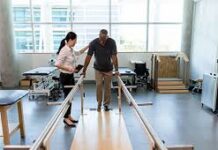Therapeutic Exercise Equipment
Exercising can be an important part of a healthy lifestyle. It can help strengthen the heart, improve overall fitness, and reduce stress levels. But when it comes to exercise, there are so many different types of equipment available that it can be hard to decide what’s right for your needs. If you’re looking for therapeutic exercise equipment that is specifically designed to help you achieve your fitness goals, look no further than resistance bands, balance boards, hand weights, exercise balls, foam rollers and Pilates rings.
Occupational therapy equipment
Occupational therapy equipment such as resistance bands are a great way to increase strength and flexibility without putting too much strain on the body. They come in various shapes and sizes so you can target specific muscle groups while still getting a full-body workout. With resistance bands you don’t need any other type of equipment or special clothing; simply hold onto one end of the band and move it in whatever direction feels comfortable for your body as you stretch or pull against the tension created by the band itself.
Balance boards
Balance boards are another great piece of therapeutic exercise equipment that helps with balance training and core stability exercises such as squats or planks. Balance boards come in different shapes such as round discs or curved surfaces which allow users to adjust their position accordingly. Yet another modern technology is related lumenis laser, which has all the potential to treat various deceases very effectively.
Evaluation Instrument
Evaluation Instruments are tools used to measure and assess a student’s learning development. There are two main types of evaluation instruments: performance-based assessments and computerized tests and questionnaires. These instruments help educators understand what students have learned in the classroom, gauge their progress, and provide feedback on their overall performance.
Performance-based assessments are designed to measure a student’s ability to apply knowledge in real-world situations. This type of assessment typically includes tasks such as problem solving, writing or presenting projects, or participating in simulations or role-playing activities. Performance-based assessments evaluate a student’s ability to think critically and use knowledge gained from the classroom in new ways. They also allow educators to identify areas where additional instruction is needed for individual students or groups of students.
Computerized tests and questionnaires can be used to assess the development of skills such as reading comprehension, math proficiency, language usage, scientific understanding, research abilities and more. These types of tests present questions that require written responses or multiple choice answers depending on the subject matter being assessed. Computerized tests can provide an accurate picture of a student’s academic performance over time by tracking responses throughout different testing periods (e.g., midterms). Additionally, these tests may include
Adaptive Equipment: Enhancing Mobility and Communications for People with Disabilities
Adaptive equipment is designed to assist individuals with disabilities who are unable to perform certain tasks on their own. These tools provide physical support, allowing people with disabilities to achieve greater independence and mobility. Examples of adaptive equipment include wheelchairs, walkers, prosthetic limbs, orthoses, augmentative communication devices (ACDs) and environmental control units (ECUs).
Wheelchairs and Walkers: Wheelchairs are a type of adaptive equipment that allow individuals who are unable to walk or experience mobility difficulties due to physical impairments or illnesses the ability to move around independently. They also come in various sizes and configurations for different needs. Walkers are designed for those who can bear some weight but need assistance in walking due to muscle weakness or balance issues.
Prosthetic Limbs and Orthoses: Prosthetic limbs are artificial replacements created specifically for people with limb loss injuries caused by accidents or medical conditions such as diabetes and cancer. They not only provide support but also help restore a person’s natural movement patterns so they can participate fully in everyday activities like walking, running or swimming. Orthoses provide stability by supporting weakened muscles as well as correct posture deformities that results disabilities.
Assistive Technology
Assistive Technology is a term that refers to any type of device, software program, or system that helps people with physical, sensory, or cognitive disabilities. Assistive technology can be used in many areas of life such as education, work, and leisure activities. This article will provide an overview of three common types of assistive technology: computer software programs; cushions, seating and positioning systems; and augmentative communication devices.
Computer Software Programs are specialized pieces of software designed to help individuals who have difficulty using standard computer applications. Common examples include voice recognition software which allows users to control their computers by speaking instead of typing; text-to-speech programs which reads text aloud for those with visual impairments; and screen readers which provide audio feedback for those with limited vision or who are blind. These types of programs allow individuals to access the same information others do but in a more accessible format.
Cushions, Seating and Positioning Systems are designed to help support people who have trouble sitting upright on their own or need extra support while seated in a wheelchair or other chair/seat. These systems can range from simple foam wedges used as cushioning all the way up to complex motorized chairs that can be adjusted electronically for the user’s specific needs.
Sensory Integration Tools
Sensory integration tools are devices used to help individuals with Autism or Sensory Processing Disorder (SPD) regulate their sensory systems. These tools provide a calm and calming environment for individuals, helping them to feel more centered and in control of their environment.
Swings are one of the most popular and widely used sensory integration tools. They can be installed indoors or outdoors, depending on individual preference. Swinging helps individuals with Autism or SPD relax by providing vestibular input, which is important for regulating body movement and body position awareness. It also provides calming proprioceptive input through the feeling of weightlessness as the person swings back and forth in a rhythmic motion.
Rocking chairs also offer vestibular input but do not provide as much movement as a swing does. Rocking chairs help create a safe place for individuals who may be feeling overwhelmed by their environment due to sensory overload, allowing them to concentrate on their breathing while providing gentle rocking motions that help soothe the individual’s body into relaxation mode.
Squeeze machines provide deep pressure touch therapy that helps people with Autism or SPD self-soothe when they become overwhelmed or agitated due to environmental stimuli such as noise levels, lights, temperature changes etc.
Write and Win: Participate in Creative writing Contest & International Essay Contest and win fabulous prizes.
















